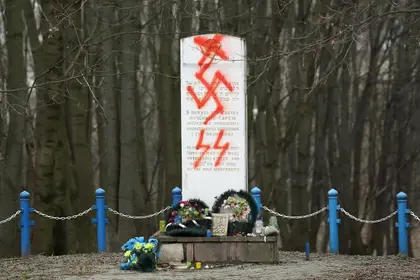Ukraine has joined the unenviable list of countries that saw a dramatic increase in anti-Semitism in 2017, according to the annual report on anti-Semitism in the world, presented on Jan. 22 by Israel’s Diaspora Affairs Minister Naftali Bennett.
Bennet said that according to statistics from Ukraine, the number of anti-Semitic incidents in the country doubled in 2017.
JOIN US ON TELEGRAM
Follow our coverage of the war on the @Kyivpost_official.
But the Israeli report generated a backlash in Ukraine, a country with a Jewish population of up to 100,000. Some branded the report baseless and even claimed it might be yet another Kremlin attempt to portray Ukrainians as fascists.
- Check out the newest war in ukraine update in the Kyiv Post’s news pieces published today.
- Access the newest Ukraine news items published today.
Josef Zisels, the chairman of the Association of Jewish Organizations and Communities of Ukraine VAAD, told the Kyiv Post on Jan. 29 that the authors of the report used information from the internet and hadn’t conducted a deep enough study to make such serious accusations.
Vyacheslav Likhachov, the head of the National Minorities rights monitoring group in Ukraine, told Radio Svoboda on Jan. 27, that the monitoring group had indeed recorded a rise in anti-Semitic attacks in Ukraine – from 19 in 2016 to 24 in 2017.
“(But) those were mostly acts of vandalism against Jewish monuments. We recorded only one physical attack in 2016, and none in 2017,” Zisels said.
Hate crimes
The original anti-Semitism report was published in Yiddish, but according to the official website of the European Jewish Congress, during his presentation Bennet mentioned Ukraine, Germany, Poland, the United Kingdom and the United States as being countries that had seen increasing verbal attacks against Jews, as well as acts of vandalism against Jewish historical monuments and synagogues.
Although ethnic hatred can be an aggravating factor under Ukrainian legislation, there is no separate article on hate crime in the Ukrainian criminal code. Frequently, hate crimes are categorized and investigated as acts of hooliganism or vandalism in Ukraine.
According to the latest crime statistics published by State Statistics Service of Ukraine, in 2016 people in Ukraine committed more than 592,000 crimes: 68 percent were crimes against property, 7 percent against individuals, and only 1.1 percent – crimes against electoral, labor and “other individual rights of citizens.”
Viktor Kaganovich, a 47-year-old graphic designer who repatriated to Ukraine from the U.S in 2008, recalls that he was pleasantly surprised to find that anti-Semitism was seen “as a shameful sentiment fit only for scoundrels.”
However, he saw a change come after the EuroMaidan Revolution of 2014.
“Recently the anti-Semitic rhetoric has become the new norm, on social media or in high offices,” Kaganovich told the Kyiv Post on Jan. 29.
Kaganovich blamed the recent trend of glorification of the Ukrainian Insurgent Army and its controversial leaders Stepan Bandera and Roman Shukhevych.
Vandalism
Fortunately, physical attacks on Jewish people decreased all over the world in 2017, Bennet said.
However, the increasing number of verbal attacks and hatred expressed on the internet have really become a disturbing tendency, he said.
The National Minorities rights monitoring group recorded several anti-Semitic attacks in the first half of 2017.
On April 18, unknown persons vandalized a monument to the victims of a mass shooting committed during the Holocaust in the World War II in the town of Kostopil of Rivne Oblast. Vandals drew a swastika on the Holocaust monument, reads the group’s report.
“Students of the local construction and technology college cleaned the Nazi symbols off the monument the same day. And the head of Kostopil District Council Oleksandr Sereda filed a statement with the police,” reads the report of the National Minorities rights monitoring group in Ukraine.
On April 27 an unknown person vandalized a monument to Holocaust victims in the village of Petrykiv near Ternopil, a city in western Ukraine, some 420 kilometers west of Kyiv.
Vandals crossed out the Jewish Star of David symbol and painted a red swastika and the double lightning symbol of the Waffen SS of Nazi Germany.
The monument was erected at the place where 16,000 Jewish people were executed in 1941 during the World War II.
On Dec. 26, vandals daubed three buildings in Odesa with neo-Nazi Wolfsangel symbols: the Brodska Synagogue, the Holocaust Museum and the Beit Grand Jewish Cultural Center.
Provocations
“We can’t really prove it, but many of those incidents could be Russian-backed provocations. As Ukraine is constantly fighting mostly on ideological war (with Russia),” Zisels said.
Zisels said Ukrainian law enforcers are partly to blame for Ukraine having such a negative image.
“We reported all the vandalism acts against the Jewish people to the police and prosecutors, but in four years not a single anti-Semitism case has been investigated and taken to the court. So we really can’t even say which acts were Russian provocations, and which were really anti-Semitism,” Zisels said.
Editor’s Note: This article is a part of the “Journalism of Tolerance” project by the Kyiv Post and its affiliated non-profit organization, the Media Development Foundation. The project covers challenges faced by sexual, ethnic and other minorities in Ukraine, as well as people with physical disabilities and those living in poverty. This project is made possible by the support of the American people through the U. S. Agency for International Development and Internews. Content is independent of the donors.
You can also highlight the text and press Ctrl + Enter




